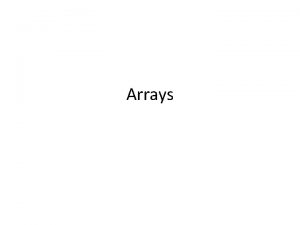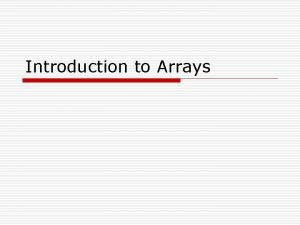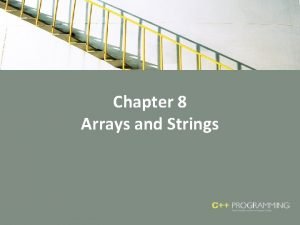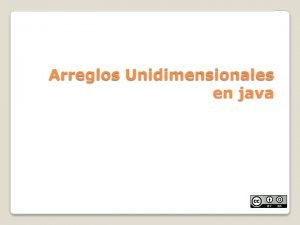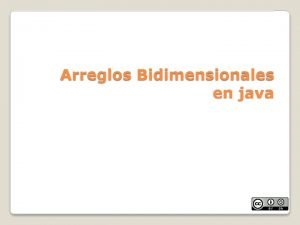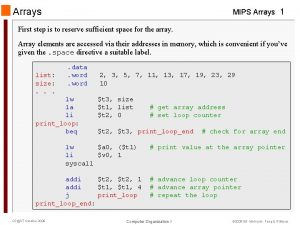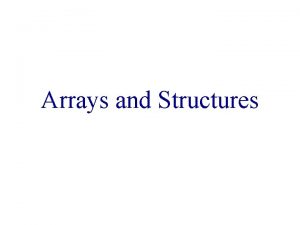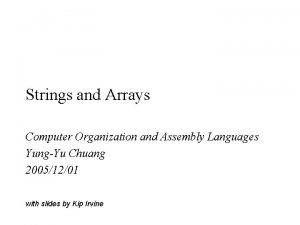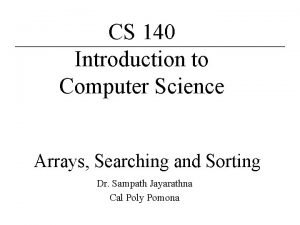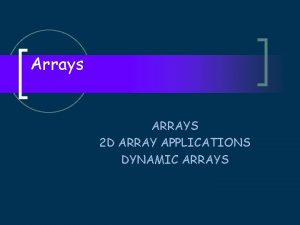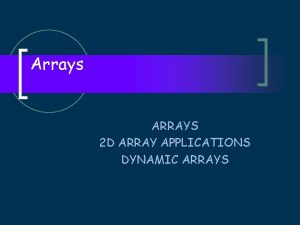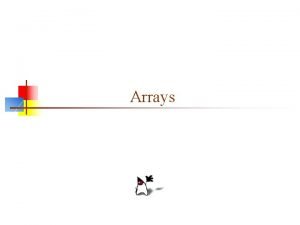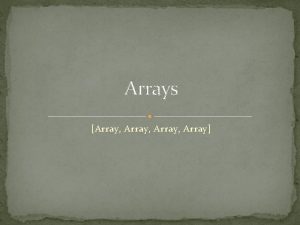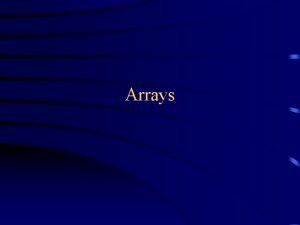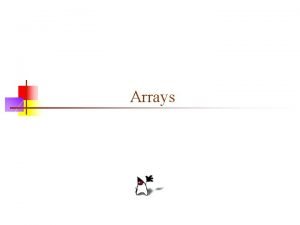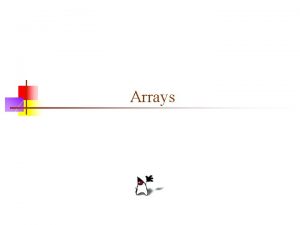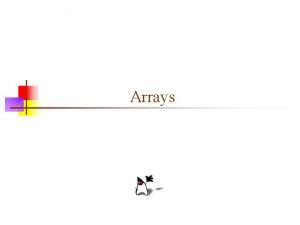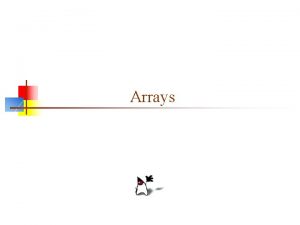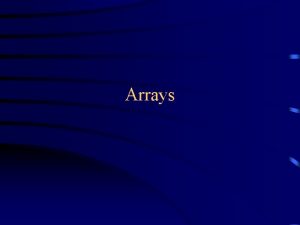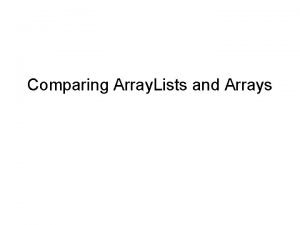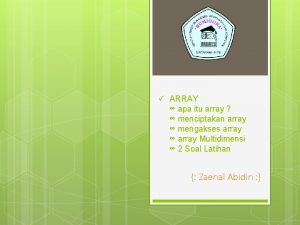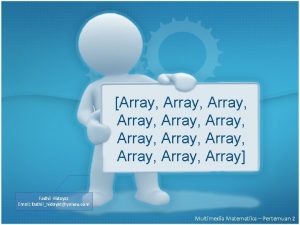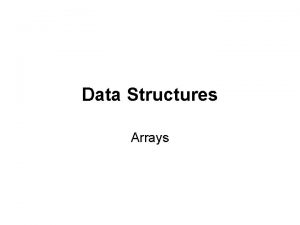Arrays The array data structure n An array













![Ragged arrays int ragged[][] = new int[4][]; for (int i = 0; i < Ragged arrays int ragged[][] = new int[4][]; for (int i = 0; i <](https://slidetodoc.com/presentation_image_h2/0eda75c932131be323733ced8b97d347/image-14.jpg)





- Slides: 19

Arrays

The array data structure n An array is an indexed sequence of components n n Typically, the array occupies sequential storage locations The length of the array is determined when the array is created, and cannot be changed Each component of the array has a fixed, unique index n Indices range from a lower bound to an upper bound Any component of the array can be inspected or updated by using its index n This is an efficient operation: O(1) = constant time 2

Array variations I n n n The array indices may be integers (C, Java) or other discrete data types (Pascal, Ada) The lower bound may be zero (C, Java), one (Fortran), or chosen by the programmer (Pascal, Ada) In most languages, arrays are homogeneous (all components must have the same type); in some (Lisp, Prolog) the components may be heterogeneous (of varying types) 3

Array variations II n n In an object-oriented language, arrays may be objects (Java) or not objects (C++) Arrays may carry additional information about themselves, such as type and length (Java), or may consist only of their components (C, C++) n n I will use the terms reflective and non-reflective, respectively, to refer to these two types of arrays This is not standard terminology, but it is consistent with other uses of the terms 4

Arrays in Java I n n n Array indices are integers An array of length n has bounds 0 and n-1 Arrays are homogeneous n However, an array of an object type may contain objects of any subtype of that object n n For example, an array of Animal may contain objects of type Cat and objects of type Dog An array of Object may contain any type of object (but cannot contain primitives) 5

Arrays in Java II n Arrays are objects n n n Arrays are allocated by new, manipulated by reference, and garbage collected However, the usual bracket notation a[i] is provided as syntactic sugar Arrays are reflective n n a. length is the length of array a a. get. Class() is the type of array a n An array of integers has type [I n An array of Strings has type [Ljava. lang. String; 6

Arrays in Java III n Here’s one way to visualize an array in Java: my. Array class tag length 0 1 2 3 [I 4 17 23 948 3 7

Subarrays n A subarray is a consecutive portion of an array 0 1 2 3 4 5 6 7 8 9 array a [I 10 1 1 2 3 5 8 13 21 34 55 subarray a[2. . . 6] n n n Java provides no language support for subarrays To use a subarray, you must keep track of (1) the array itself, (2) the lower bound, and (3) the upper bound Typically, these will be three parameters to a method that does something with the subarray 8

Array as an ADT n An array is an Abstract Data Type n The array type has a set of values n n The array type has a set of operations that can be applied uniformly to each of these values n n n The values are all the possible arrays The only operation is indexing Alternatively, this can be viewed as two operations: n inspecting an indexed location n storing into an indexed location It’s abstract because the implementation is hidden: all access is via the defined operations 9

Subarray as an ADT n n As noted earlier, to use a subarray, you must keep track of (1) the array itself, (2) the lower bound, and (3) the upper bound This suggests: class Subarray<V> { V[ ] subarray; int lower. Bound; int upper. Bound; // Constructor, some methods. . . } n Advantage: n n Only one object to pass around Disadvantages: n n The subarray must hold Objects, not primitives You lose the nice array syntax 10

Two-dimensional arrays I n Some languages (Fortran, Pascal) support two-dimensional (2 D) arrays: columns rows a b c d e f g h i j k l logical view n A two-dimensional array may be stored in one-dimensional computer memory in either of two ways: row 0 row 1 row 2 row major order: a b c d e f g h i j k l col 0 col 1 col 2 col 3 column major order: a e i b f j c g k d h l 11

Two-dimensional arrays II n In a 2 D array, we generally consider the first index to be the row, and the second to be the column: a[row, col] 0 1 rows 2 3 n n 0 0, 0 1, 0 2, 0 3, 0 columns 1 2 3 0, 1 0, 2 0, 3 1, 1 1, 2 1, 3 2, 1 2, 2 2, 3 3, 1 3, 2 3, 3 4 0, 4 1, 4 2, 4 3, 4 In most languages we don’t need to know the implementation-we work with this abstraction In C and C++, we do need to know the implementation 12

2 D arrays in Java doesn’t have “real” 2 D arrays, but array elements can themselves be arrays: n n n We can define the above array like this: x = new int[5][8]; and treat it as a regular 2 D array This is an array of 5 arrays n n int x[][] denotes an array x of array components, each of which is an array of integer components Each subarray is an array of 8 ints However, we can do fancier things than this with arrays in Java 13
![Ragged arrays int ragged new int4 for int i 0 i Ragged arrays int ragged[][] = new int[4][]; for (int i = 0; i <](https://slidetodoc.com/presentation_image_h2/0eda75c932131be323733ced8b97d347/image-14.jpg)
Ragged arrays int ragged[][] = new int[4][]; for (int i = 0; i < 4; i++) { ragged[i] = new int[i + 1]; } 0 1 2 3 0 0 1 10 11 2 20 21 22 3 30 31 32 33 for (int i = 0; i < 4; i++) { for (int j = 0; j < ragged[i]. length; j++) { ragged[i][j] = 10 * i + j; } } 14

Inserting an element into an array n n Suppose we want to insert the value 8 into this sorted array (while keeping the array sorted) 1 3 3 7 12 14 17 19 22 30 We can do this by shifting all the elements after the mark right by one location n Of course, we have to discard the 30 when we do this 1 3 3 7 8 12 14 17 19 22 30 • Moving all those elements makes this a slow operation (linear in the size of the array) 15

Deleting an element from an array Deleting an element is similar--again, we have to move all the elements after it n n n 1 3 3 7 8 12 14 17 19 22 ? Deletion is a slow operation; we don’t want to do it very often Deletion leaves a “vacant” location at the end n How do we mark it vacant? n n Every bit pattern represents a valid integer We must keep a count of how many valid elements are in the array 16

Vectors and Array. Lists n Vector methods include the following: n n n Array. List methods include the following: n n public void insert. Element. At(Object elem, int index) public void remove. Element. At(int index) public void add(int index, Object elem) public void remove(int index) These are slow (linear time) methods Should we avoid using these methods? n n n Use them if this is the best way to make your program code simple and easier to understand Don’t use them if there is an equally simple alternative Don’t use them if extreme speed is required, and there is a faster alternative 17

Conclusions n Arrays are not identical in all languages n Arrays have the following advantages: n n Accessing an element by its index is very fast (constant time) Arrays have the following disadvantages: n n n All elements must be of the same type The array size is fixed and can never be changed Insertion into arrays and deletion from arrays is very slow 18

The End 19
 What are the advantages of arrays?
What are the advantages of arrays? Parallel arrays
Parallel arrays Array of arrays c++
Array of arrays c++ Static data structure
Static data structure Algorithm of traversing an array in data structure
Algorithm of traversing an array in data structure Addition of two polynomials using linked list in c
Addition of two polynomials using linked list in c Representation of linear array in data structure
Representation of linear array in data structure Java array operations
Java array operations Veteork
Veteork C++ parallel arrays
C++ parallel arrays Why do we need arrays?
Why do we need arrays? Dynamic arrays and amortized analysis
Dynamic arrays and amortized analysis Variables unidimensionales ejemplos
Variables unidimensionales ejemplos Java arreglos bidimensionales
Java arreglos bidimensionales Mips arrays
Mips arrays Polynomial representation using array in c
Polynomial representation using array in c Assembly array of strings
Assembly array of strings Global arrays in c
Global arrays in c Computer science arrays
Computer science arrays Searching and sorting arrays in c++
Searching and sorting arrays in c++




